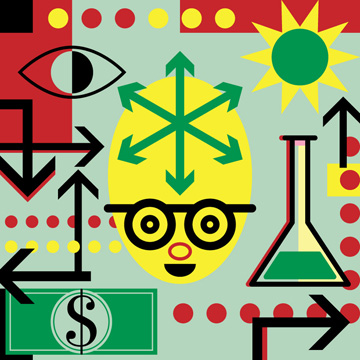Ask technology observers to tease out a crisp snapshot of Dallas-Fort Worth’s future from the current brooding haze of economic uncertainty, and they demur. It’s difficult to grasp the entire picture, they say, to get a clear sense of all the activity simmering under the surface. “Sometimes you don’t know about the best things that are happening until they have happened,” says Terry Clower, director of the Center for Economic Development and Research at the University of North Texas.
Yet Clower believes DFW is ideally positioned to successfully flex and pivot, no matter what opportunities the current disruptive turmoil breeds. Scattered around the region are hotbeds of significant innovation in bioscience, information technology, energy and energy management systems, and materials science and nanotechnology. Example: In March 2009, researchers at the University of Texas at Dallas announced they had developed artificial muscle rendered from carbon nanotube aerogel sheets. Composed primarily of air, the muscle can operate at extreme temperatures and has potential applications in medicine and in solar cells. Clower says a few regional firms are ready to pounce on such materials opportunities, but he won’t name names.
What he points to is the wealth of human capital DFW has to deploy at opportunities. The tech wreck that accompanied the turn of the century idled an abundance of highly skilled engineers in disciplines such as optics and telecommunications. These engineers didn’t vacate the area, as the wreckage was global. These skills can be parlayed into emerging technologies.
“Dallas is well-positioned,” says Dell Services (formerly Perot Systems) Chief Innovation Officer Jim Stikeleather. “Dallas is a communications hub. At the end of the day the bloodstream of the next-generation economy is going to be the communication lines.”
Let There be Light
Dallas is also ground zero for an emerging photonics industry, or the utilization of light to transmit and process information. Photonics technology is currently being deployed in advanced network routers to overcome bandwidth limitations, and in the biotech industry, specifically in neural interfaces. Converting nerve impulses into light signals, neural interfaces provide a direct connection from the brain to an external device, such as a sophisticated prosthetic limb.
“In neural interfaces we’ve got some of the best capability in the world here,” says Marc Christensen, chair of the department of electrical engineering at Southern Methodist University. “So I think that’s an exciting area that will explode.” Christensen has just launched a neural-photonics center and is building a fiber optic interface to the nervous system at SMU in collaboration with UTD and the University of North Texas.
But what may be the most fertile sphere as the next economy coalesces is adding silicon brains to old technologies. Don Hicks, professor of political economy and public policy at UTD, envisions planting smart chips and wireless connectivity into medical devices, transforming responsive, reactive medicine into anticipatory medicine: a virtual blanket of care.
“When you have as your regional jewels competence in innovating information communication technology systems, making everything smarter, more efficient, and more responsive, you are really sitting on a gold mine,” Hicks says.
The energy sector is also looking to integrate smarts. Dallas-based Broadstar Wind Systems, for example, is developing a new class of wind turbine technology that puts turbines at the point of energy consumption. With its patented AeroCam technology, Broadstar systems are designed to generate energy from turbulent urban environments. The turbines can be mounted on commercial building rooftops or industrial towers.
Up in the Clouds
But perhaps the most robust sector in the region is information technology. Stikeleather of Dell Services suggests IT could be the most consequential element in the future of the DFW economy. Companies are gradually shedding what Stikeleather calls hygienic functions such as accounting, payroll, and human resources.
Successful companies will outsource such IT-intensive operations to the “cloud,” that confluence of Internet technologies that provides computing services and software on-demand, much like the electrical grid provides on-demand power. “Over the next five years cloud computing is probably going to be the primary driver of technology and the technology space,” says Stikeleather. “I can just go out and buy it by the drink in the cloud. …
“A lot of people make the mistake of thinking that technology causes change,” he adds. “But that’s really not the case.” What technology does, Stikeleather says, is “facilitate changes that want to take place, but don’t have the capability to do so yet.”






